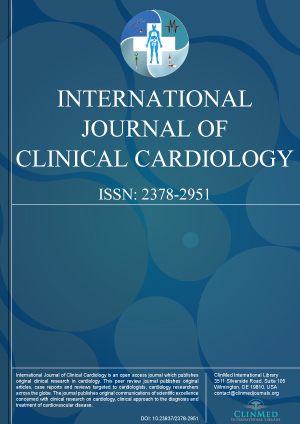Open Access DOI:10.23937/2378-2951/1410137
Complete Right Bundle Branch Block in Arrhythmogenic Cardiomyopathy: Similarities to Brugada Syndrome
Stefan Peters
Article Type: ORIGINAL ARTICLE | First Published: February 14, 2019
Brugada syndrome is characterized by coved-type ST-segment elevation in one or two right precordial leads. Two types of coved-type ST elevation has been described: A form of complete right bundle branch block (about 60%), in which right precordial leads demonstrate complete block and left precordial leads reveal nearly normal QRS configuration. In about 40% complete right bundle branch block with nearly identically increased QRS intervals....
Open Access DOI:10.23937/2378-2951/1410136
The Prognostic Significance of Elevated Cardiac Troponin in Non-Cardiac Medical Disorders. Pilot Study
Ibrahim AlQassas, MD, Walid Hassan, MD, MACP, Nadia Sunni, MD, Mohammed Lhmdi, MD, Alaa Nazzal, MD, Mohammed J Mohamed, Farhan Dar, MD, Sahar Sharafeldin, MD, Amr Aljareh, MD, Hasan Balubaid, MD, Basema Alshengiti, MD, Ehab Hasan, MD, Heba Waez, MD, Sarah Bahnshal, MD, Momen Nassani, MD, Mohammed Al-Kulak, MD, Maha AlKudsi, MD, Hala Zein Elabidinm, MD and Ibrahim Mansour, MD
Article Type: RESEARCH ARTICLE | First Published: February 14, 2019
Most troponin TnT-HS samples (77.1%) were obtained from emergency room (ER) attendance and 63.4% of patients were male. The mean age was 72 years and no correlation was found between age and troponin levels (the statistical number r value needs to be put here). Although expectedly patients with diagnosis of acute coronary syndrome displayed TnT-HS values significantly higher than those of other groups, positivity to TnT-HS (> 40 ng/l) was also observed in patients with other clinical conditions....
Open Access DOI:10.23937/2378-2951/1410135
Spontaneous Coronary Artery Dissection and the Takotsubo Syndrome: An Association to be Taken into Account
Veronica Hernandez Jimenez, Aranzazu Garcia Romero and Jesus Saavedra Falero
Article Type: Case Report | First Published: January 16, 2019
Spontaneous coronary artery dissection (SCAD) and Takotsubo syndrome (TTS) are two causes of acute non-arteriosclerotic myocardial infarction. These two entities share some characteristics such as greater involvement in women, preceded by an emotional stressor and an etiopathogeny not clearly known. Recently it has been seen that these two entities may be related. We describe a case of a young woman with a myocardial infarction due to a SCAD who developed a TTS. A 44-year-old woman, without know...
Open Access DOI:10.23937/2378-2951/1410134
Myocardial Infarction Secondary to Multiple Coronary-Pulmonary Fistula in a High Performance Athlete
Gil Ramirez Andreina, Burgos Lucrecia Maria, Chillik Ivan Ezequiel, Pelletier Maria, Larocca Calvino Mariana, Spaletra Pablo and Elizari Maria Amalia
Article Type: Case Report | First Published: January 14, 2019
The incidence of CF is 0.002% of general population, observed in 0.2% of adult patients undergoing coronary angiography. More frequently of congenital origin, they have also been described related to invasive procedures, chest trauma or post myocardial infarction. In 55% of cases they are originated from the right coronary artery, in 35% from left coronary artery and 5% in both simultaneously. Seventy percent of CF drain into right cavities (low pressure circuits), 15% into pulmonary artery and ...

